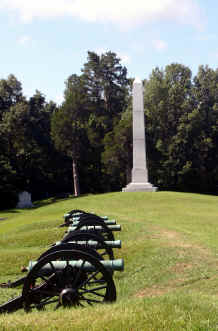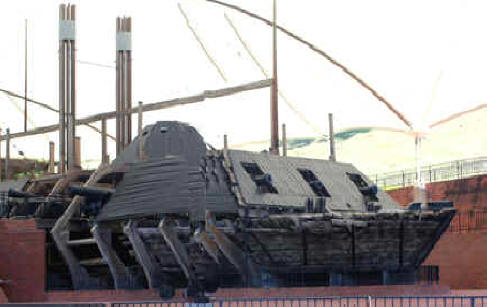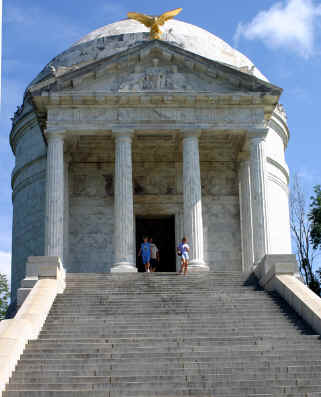 |
Silent cannons mark the battlefield today. |
Gibraltar of The South
Photos and article by Kathleen Walls
Undoubtedly
the biggest draw for visitors to Vicksburg is the Battlefield Park. Vicksburg was critical
to both sides from the beginning of the war. Until the Union could control the entire
river to Cairo, Illinois, they could not prevent the South from supplying their armies.
Whoever controlled Vicksburg controlled the river.
Vicksburg
was called the "Gibraltar of the Confederacy."
It stood on a bluff guarding the river and was protected by heavy artillery
on the bluff and a ring of forts that protected it from land. The key players in this
drama were Union General Grant who attempted first to attack the city and then laid siege
to compel the surrender, and General Sherman who attempted to take Vicksburg from the
south. The chief Confederate here was General John Pemberton, who repulsed the original
attacks but could not withstand the long siege.
This was
a battle site where not only soldiers were casualties but civilians. The bombardment
forced the residents to take shelter in caves. The bombardment was not the biggest killer
however; starvation and disease were the main culprits. The Union forces fouled all the
streams flowing into the city and prevented any provisions from reaching the desperate
people. By the end of the siege, rats were being sold to those lucky enough to get them at
the butcher shops.
The
battlefield is considered very haunted, as are most places where this many lives were cut
down suddenly in their prime. Reports of cannon fire, unusual fogs, whispers and the smell
of gunpowder have all been experienced. Phantom soldiers have been glimpsed among the
trees.
The fogs
are the most common. There were two different episodes I discovered of people seeing them.
One man was visiting an area where some of the heaviest fighting had taken place and
suddenly a portion of the area was engulfed by a low fog that only stood about a foot off
the ground.
Another
man witnessed a similar occurrence. It was around twilight and he was in the park for his
regular run. He came to the cemetery and saw an eerie fog. It was about a foot above the
ground and came up to the middle of most of the gravestones, It only was in that portion
of the park, nothing but the graves were engulfed. The cemetery was designated for only
Union soldiers. So be sure and visit the National Cemetery. No telling what you might see.
If you should see a phantom Confederate soldier there, somehow two Confederates slipped in
and are buried there: Ruben White from Texas and Charles Brantly from Arkansas.
 |
The Cairo |
Vicksburg's fall followed by Port Hudson
nearby in Louisiana, gave the North full control of the Mississippi River. The Confederacy
was sliced in half. The Vicksburg battlefield includes 1,330 monuments and markers, a
sixteen-mile tour road, a restored Union ironclad called the Cairo, The Shirley House that
is the only surviving structure in the battlefield and a National Cemetery.
Strange
thing happen in a battle, especially one as fierce as Vicksburg. One of those is the story
of Union Maj. Gustavus Lightfoot. He had been saving some especially expensive cigars for
a really special occasion. Just before the battle he broke open the cigars and passed them
around to his comrades saying "I won't be needing these anymore." Sure
enough he was killed in the next battle.
 |
Illinois Monument with Old Abe on top |
Battles
of this magnitude often leave behind stories of heroism above and beyond. One such story
is that of 13-year-old Orion P. Howe, a young drummer and fife player for Company C, 55th
Illinois Infantry. Orion was severely wounded in the leg but he refused to leave the
field. Instead he would crawl up and down the hill to report when his battalion needed
more ammunition. He was awarded the Congressional Medal of Honor for his bravery in the
field.
Illinois
monument recognizes Orion along with all of its fighting men – and woman. That's
right. There was a woman enlisted in the Illinois infantry.
Private
Albert D. J. Cashier mustered out with the remainder of the regiment on August 17, 1865
after serving for three years and 11 days in the ranks. But Albert had a secret.
"He" was a "she."
Even
after the way ended, "he" lived as man. Cashier joined the Grand Army of the
Republic, the largest organization of Union veterans. When Cashier applied for a pension
in 1899, "he" was examined by three surgeons to determine "his"
eligible for a veteran's pension.
It
wasn't until 1911, almost 50 years after Vicksburg that Cashier was struck by an
automobile. The doctor, who was summoned to examine the old soldier, noted a broken leg.
Just in case there were other unknown injuries, he farther examined Cashier. Imagine his
surprise when he discovered that Cashier was a woman but, after listening to the old
soldier's pleas, agreed to maintain her secret.
But
things did not continue as "he" wished. Just three months later, the old veteran
was forced to move into the Soldiers' and Sailors' Home in Quincy, Illinois. Even as
"his' health deteriorated, Cashier attempted to continue the male identity.
"He" was successful for only three more years when a mental condition led to
confinement in an insane asylum at Watertown, Illinois. There she was finally compelled to
wear female attire and live the life of a woman. In death, Cashier was partially allowed
to revert to the male role. "His" tombstone reads "Albert D. J. Cashier,
Co. G,95 ILL Inf Civil War, Born : Jennie Hodgers, In Clogher Head, Ireland 1843 –
1915."
Pennsylvania's
Monument is simple compared to some. It is a granite shaft at the back of an elliptical
platform with a flight of three steps. It has five bronze medallions portraying the five
unit commanders who fought here. It drew a lot of attention when someone noticed the faces
in the medallions "weeping." Apparently,
it was not real flesh and blood tears they were shedding but a dripping of the
condensation from dew.
One of
the most interesting legends concerns the Wisconsin Monument. It's a granite column
that stands one hundred and twenty two feet in height. A bronze statue of an eagle sits
atop it. That eagle was Old Abe, the 8th Wisconsin Company C.'s mascot. He was mean and went through several handlers as
he had a habit of biting them until they passed the ornery bird on to another hapless
caretaker. Non-the less, the Company C boys loved him so much they were called the
"Eagle Regiment." The Confederates hated him and called him "the Yankee
Buzzard." They tried to shoot him but only wounded him once. When the war ended he
was given a place of honor in Madison at the state capital building. There was a fire and he died from smoke
inhalation but they had him stuffed and put back in the capital. Then another fire
devoured the tough old bird but he is honored with a bronze eagle monument in Madison to
this day. Legend says you might see his spirit circling the battlefield still.
The battlefield park has the only monument
dedicated to African American in any national military park. It was erected on 2-14-2004
by the state of Mississippi and honors the units that fought at Milligans Bend across the
river in Louisiana. The monument consists of three bronze figures on a base of black
African granite. Two of the figures are black Union soldiers, the third a common field
hand. The field hand and one soldier support the second soldier between them. That soldier
is wounded to represents the sacrifices made by African-Americans on the battlefield
during the Civil War. The field hand is looking back at a past of slavery and the first
soldier gazes toward a future of freedom.
Another
monument with an interesting legend is that of General Grant. Grant is mounted on his
horse, Kangaroo. He had three horses he used here. One was called Cincinnati. The other
was a small horse he stole from Jefferson Davis's brother's plantation. He named
that horse "Jeff Davis." The story is that when the park was open 24 hours, you
could come in at night and visit General Grant and he would tip his hat and look at you.
Vicksburg Battlefield Museum
4139 I-20 Frontage Road
601-638-6500
www.vicksburgbattlefieldmuseum.com
Vicksburg National Military Park
3201 Clay St
Vicksburg, MS 39183
(601) 636-0583
http://www.nps.gov/vick/
This an excerpt from my new book, Hosts With Ghosts:
Haunted Historic Hotels in the Southeast. It will be released in mid October
at $19.99. If you would like to preorder an autographed copy prior to Oct., 15, 2007 at
the advance price of $15.99 plus $2 S & H, click
here. You may pay by PayPal, check or credit card.
|